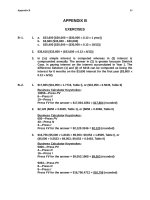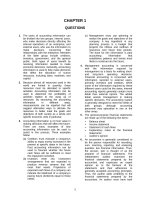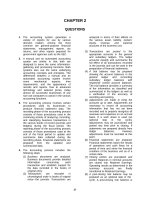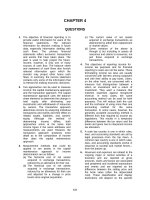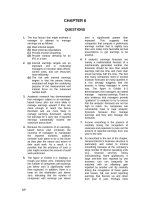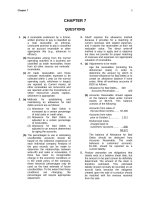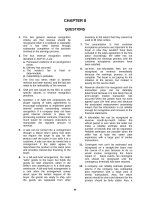Solutions manual intermediate accounting 18e by stice and stice ch03
Bạn đang xem bản rút gọn của tài liệu. Xem và tải ngay bản đầy đủ của tài liệu tại đây (258.85 KB, 44 trang )
To download more slides, ebook, solutions and test bank, visit
CHAPTER 3
QUESTIONS
6. a. Cash is classified as noncurrent when
it is a part of a fund that will be used to
discharge noncurrent obligations. Such
funds include bond retirement funds,
pension funds, and preferred stock redemption funds. Cash to be used for
the acquisition of land, buildings, and
equipment or cash received on longterm deposits from customers would
also be reported as noncurrent.
b. Receivables not reportable as current
assets include those arising from unusual transactions, such as the sale of
land, buildings, and equipment or advances to affiliates or employees that
would not be collectible within 12
months.
7. If a short-term loan is expected to be refinanced or paid back with the proceeds of a
replacement loan, the existing short-term
loan is not classified as current. This is true
as long as the intent of the company is to
refinance the loan on a long-term basis and
the company’s intent is evidenced by an
actual refinancing after the balance sheet
date or by the existence of an explicit refinancing agreement.
8. a. A subjective acceleration clause is a
provision in a debt instrument that specifies some general conditions permitting a lender to unilaterally accelerate
the due date.
b. An objective acceleration clause is a
provision in a debt instrument that specifies conditions that can cause the
debt to be immediately callable, for example, failure to earn a certain return
on the assets or to make an interest
payment.
c. If a noncurrent debt instrument contains a subjective acceleration clause
and the invoking of the clause is
deemed probable, the liability should
be classified as current. If invoking of
the clause is deemed reasonably possible but not probable, the obligation
should continue to be reported as a
noncurrent liability with a note to describe the contingency. If a debt in-
1. Three elements, as defined by the FASB,
are contained in a balance sheet: assets,
liabilities, and equity. These elements
measure the worth of an enterprise at a
given point in time. The balance sheet thus
reports what resources an enterprise has
and who has claim against those resources. Two other elements, investments
by owners and distribution to owners, are
related to the equity element. Information
concerning the change in equity is often
contained in a separate statement that
supplements the balance sheet.
2. In order to meet the definition of an asset,
an item need not be associated with certain
future benefit. To acknowledge the uncertainty inherent in business, the definition of
an asset stipulates that the future benefit
need be only probable.
3. Some liabilities, such as accounts payable
and long-term debt, are denominated in
precise monetary terms. However, the
amounts of many liabilities must be estimated based on expectations about future
events.
4. The difference between current assets and
current liabilities, referred to as working
capital, is a commonly used measure of the
liquidity of an enterprise. It helps to determine whether the company will be able to
meet its current debts and obligations with
available assets and still continue normal
operations.
5. a. Assets are classified as current if
(1) the asset will be realized in cash
during the normal operating cycle
of the business or 1 year, whichever is longer, or
(2) the asset will be sold or consumed
within a normal operating cycle or 1
year, whichever is longer.
b. Liabilities are classified as current if liquidation of the liability is expected to
require
(1) the use of current assets or
(2) the creation of other current liabilities.
57
To download more slides, ebook, solutions and test bank, visit
58
Chapter 3
strument contains an objective acceleration clause and the conditions that
trigger the call have occurred, the debt
should be classified as current. Exceptions are that (1) the creditor has
waived the right to demand payment for
a period that extends beyond the debtor’s normal operating cycle or (2) the
debtor has cured the deficiency after
the balance sheet date but before the
statements are issued, and the debt is
not callable for a period that extends
beyond the debtor’s normal operating
cycle.
13. Assets are usually presented in the order of
their liquidity, with the most liquid items
listed first.
9. Contingent liabilities could or could not give
rise to actual obligations; estimated liabilities are known to exist but the amount is
not definitely known. A company could, for
example, win or lose a lawsuit, but it is actually liable for income tax. The exact
amount of the income tax is unknown until
the final tax return is completed. The tax liability could have to be estimated at the
time financial statements are prepared.
16. Return on equity is an indicator of the overall performance of a company. Return on
equity measures the percentage return on
the stockholders' investment and is computed as net income divided by total equity.
10. With a proprietorship, owner’s equity is reported with a single capital account. In a
partnership, separate capital accounts are
established for each partner. In a corporation, a distinction is made between contributed capital and retained earnings.
11. The three major categories in a corporation's Equity section are
(a) Contributed capital, including both capital stock at par and additional paid-in
capital
(b) Retained earnings
(c) Other equity, such as treasury stock,
unrealized gains and losses on availablefor-sale securities, foreign currency translation adjustments, and unrealized gains
and losses on derivatives
12. Offset balances are used to adjust the
gross amount of balance sheet items to arrive at proper valuations. For example, allowance for bad debts is properly offset
against the gross amount of accounts receivable to show the net amount estimated
collectible. It is generally not proper to offset an asset account against a liability or
owners’ equity account because such an
offset would not be for the purpose of correctly valuing either account but rather to
condense financial data at the expense of
adequate disclosure.
14. Financial ratios are mathematical relationships
between
financial
statement
amounts. For example, return on equity is
net income divided by owners' equity.
15. Asset turnover ratio (total sales divided by
total assets) is a measure of the number of
dollars of sales generated by each dollar of
assets. The higher the asset turnover ratio,
the more efficient the company is in using
its assets to generate sales.
17. There are at least four types of notes used
by management to support the financial
statements and provide users with additional relevant information. They can be
classified as follows:
(a) Summary of significant accounting policies
(b) Additional information, both numerical
and descriptive, to support summary totals included in the financial statements
(c) Information about items that does not
meet the recognition criteria but that is
still useful to decision makers
(d) Supplementary schedules required by
the FASB or the SEC to fulfill the full
disclosure principle
18. The FASB must maintain a balance between conceptual purity and business practicality. When a conceptually correct recognition standard is criticized as impractical,
one FASB approach is to require only the
disclosure of the information rather than its
formal recognition. This sometimes mollifies businesses’ complaints about impracticality. For example, in 1994 the FASB decided to temporarily require only note disclosure of stock option values in response
to businesses’ complaints about the proposed recognition of those values as compensation expense.
19. Separate supplementary information or
schedules may be included to disclose
segment information; details about property, plant, and equipment and short-term
To download more slides, ebook, solutions and test bank, visit
Chapter 3
borrowing; and trend data for periods beyond those included in the basic statements.
20. If a subsequent event provides additional
information about items included in the financial statements, especially those whose
value has been estimated, the new information should be used to make adjustments to the amounts in the statements.
The event itself does not actually change
the value but merely provides additional information about conditions that existed at
the balance sheet date. For example, the
filing of a bankruptcy petition by a major
customer provides additional data concerning the collectibility of accounts receivable.
59
The conditions that led to the bankruptcy
were probably present at the balance sheet
date but may not have been known to the
preparer of the statements until the bankruptcy filing took place. Under these circumstances, Allowance for Bad Debts may
need adjustment to properly reflect the net
realizable value of receivables.
21. Many assets are reported at historical cost,
which is usually less than market value,
and other assets (such as homegrown
goodwill) are not included in the balance
sheet at all. Accordingly, the balance sheet
numbers are often a very poor reflection of
what a company is worth. Typically, a going
concern is worth significantly more than the
reported book value of equity.
To download more slides, ebook, solutions and test bank, visit
60
Chapter 3
PRACTICE EXERCISES
PRACTICE 3−1
WORKING CAPITAL
Current assets:
Cash...................................................................................
Inventory ...........................................................................
Total...................................................................................
$ 700
2,500
$3,200
Current liabilities:
Accounts payable ............................................................
Accrued wages payable ..................................................
Total...................................................................................
$2,400
225
$2,625
Working capital = Current assets − Current liabilities = $3,200 − $2,625 = $575
PRACTICE 3−2
CURRENT ASSETS
Current assets:
Cash...................................................................................
Investment securities (trading).......................................
Accounts receivable ........................................................
Inventory ...........................................................................
Prepaid expenses.............................................................
Total current assets .........................................................
PRACTICE 3−3
CURRENT LIABILITIES
Current liabilities:
Accounts payable ............................................................
Unearned revenue............................................................
Accrued income taxes payable.......................................
Current portion of long-term debt ..................................
Total current liabilities.....................................................
PRACTICE 3−4
$ 400
250
700
4,000
1,100
$6,450
$
700
315
9,000
10,000
$20,015
CLASSIFICATION OF SHORT-TERM LOANS TO BE REFINANCED
Current:
Loan A
Because the loan will be repaid, with cash, within one year of the balance sheet
date, it should be classified as current.
Loan B
In order to classify the loan as noncurrent, the company must have both the intent to refinance and evidence of the intent in the form of actual refinancing or a
contract to refinance before the issuance of the financial statements.
To download more slides, ebook, solutions and test bank, visit
Chapter 3
61
PRACTICE 3−4
(Concluded)
Noncurrent:
Loan C
The company intends to refinance Loan C, and the refinancing will be formalized
before the financial statements for this year have been released. Of course, the
actual formalization of the refinancing must be confirmed; this will occur before
the issuance of the financial statements.
PRACTICE 3−5
CALLABLE OBLIGATIONS
Current:
Loan A
A loan is current if it is payable on demand or will become payable on demand
within one year.
Noncurrent:
Loan B
The company is exceeding the current ratio constraint in the loan agreement;
thus, the loan is not payable on demand.
Loan C
It is “reasonably possible” that the company will violate the subjective acceleration clause. The loan continues to be classified as noncurrent, and the possibility of the loan becoming payable on demand will be disclosed in a note.
PRACTICE 3−6
CONTINGENT LIABILITIES
a.
This is an estimated liability. The company has a definite obligation that must be
estimated and reported in the balance sheet.
b.
It is possible that the company will have to make a payment under this contingent liability. The possibility is described in a financial statement note; nothing
is recognized in the balance sheet.
c.
It is probable that the company will have to make a payment under this contingent liability. Accordingly, the liability is recognized in the balance sheet if it can
be reasonably estimated.
PRACTICE 3−7
a.
STOCKHOLDERS’ EQUITY
Total contributed capital:
Preferred stock, at par.............................................
Additional paid-in capital, preferred ......................
Common stock, at par .............................................
Additional paid-in capital, common.......................
Total contributed capital .........................................
$ 3,450
150
170
8,200
$11,970
To download more slides, ebook, solutions and test bank, visit
62
Chapter 3
PRACTICE 3−7
b.
(Concluded)
Ending retained earnings:
Retained earnings (beginning)...............................
Plus: Sales................................................................
Less: Total expenses ..............................................
Dividends..................................................................
Ending retained earnings .......................................
c.
Total stockholders’ equity:
Total contributed capital .........................................
Plus: Ending retained earnings..............................
Less: Treasury stock...............................................
Total stockholders’ equity ......................................
PRACTICE 3−8
a.
Total contributed capital:
$ 400
9,000
$9,400
Total accumulated other comprehensive income:
Cumulative translation adjustment (equity
reduction), ending..............................................
Cumulative unrealized gain on available-for-sale
securities, ending ..............................................
Total accumulated other comprehensive income
(equity reduction)...............................................
c.
$11,970
9,600
(375)
$21,195
STOCKHOLDERS’ EQUITY
Common stock, at par .............................................
Additional paid-in capital, common.......................
Total contributed capital .........................................
b.
$6,500
9,700
(5,650)
(950)
$9,600
$(2,000)
1,100
$ (900)
Total stockholders’ equity:
Total contributed capital ...........................................
Plus: Retained earnings (post closing, or ending)
Total accumulated other comprehensive income
(equity reduction).................................................
Less: Treasury stock.................................................
Total stockholders’ equity ........................................
$ 9,400
1,500
(900)
(700)
$ 9,300
To download more slides, ebook, solutions and test bank, visit
Chapter 3
PRACTICE 3−9
63
FORMAT OF FOREIGN BALANCE SHEET
Noncurrent assets (or fixed assets):
Property, plant, and equipment .........................
Long-term investments ......................................
Total noncurrent assets (or fixed assets) ...
$ 8,000
1,700
$ 9,700
Current assets:
Cash......................................................................
Inventory ..............................................................
Total current assets ......................................
$ 500
2,000
$ 2,500
Current liabilities:
Accounts payable ...............................................
Short-term loans payable ...................................
Total current liabilities ..................................
$ 300
1,100
$ 1,400
Net current assets .......................................................
1,100
Total assets less current liabilities ............................
$10,800
Noncurrent liabilities:
Long-term debt....................................................
$ 3,000
Stockholders’ equity:
Common stock, at par ........................................
Additional paid-in capital ...................................
Retained earnings ...............................................
Total stockholders’ equity ............................
$
50
2,000
5,750
7,800
$10,800
PRACTICE 3−10
CURRENT RATIO
Current assets:
Cash...................................................................................
Inventory ...........................................................................
Total current assets ...................................................
$ 750
6,300
$7,050
Current liabilities:
Accounts payable ............................................................
Accrued wages payable ..................................................
Total current liabilities ...............................................
$3,700
615
$4,315
Current ratio = Current assets/Current liabilities = $7,050/$4,315= 1.63
To download more slides, ebook, solutions and test bank, visit
64
Chapter 3
PRACTICE 3−11
QUICK RATIO
“Quick” assets:
Cash...................................................................................
Accounts receivable ........................................................
Total quick assets ......................................................
$ 400
1,750
$2,150
Current liabilities:
Accrued wages payable ..................................................
$ 315
Quick ratio = Quick assets/Current liabilities = $2,150/$315 = 6.83
PRACTICE 3−12
DEBT RATIO
Liabilities:
Accounts payable ............................................................
Accrued income taxes payable.......................................
Unearned revenue............................................................
Current portion of long-term debt ..................................
Notes payable (due in 14 months)..................................
Total liabilities.............................................................
700
9,000
315
10,000
1,100
$21,115
Stockholders’ equity:
Paid-in capital...................................................................
Additional paid-in capital ................................................
Retained earnings ............................................................
Treasury stock..................................................................
Total stockholders’ equity .........................................
$ 1,750
4,000
1,000
(400)
$ 6,350
$
Total assets = Total liabilities + Stockholders’ equity = $21,115 + $6,350 = $27,465
Debt ratio = Total liabilities/Total assets = $21,115/$27,465 = 76.9%
PRACTICE 3−13
DEBT RATIO
Total liabilities = $1,300 because Accounts payable is the only liability item in the list.
Total contributed capital:
Preferred stock, at par ...............................................
Additional paid-in capital, preferred.........................
Common stock, at par................................................
Additional paid-in capital, common..........................
Total contributed capital ......................................
$ 3,450
150
170
8,200
$11,970
To download more slides, ebook, solutions and test bank, visit
Chapter 3
65
PRACTICE 3−13
(Concluded)
Ending retained earnings:
Retained earnings (beginning)..................................
Plus: Sales ..................................................................
Less: Total expenses .................................................
Dividends ....................................................................
Ending retained earnings.....................................
$ 6,500
9,700
(5,650)
(950)
$ 9,600
Total stockholders’ equity:
Total contributed capital............................................
Plus: Ending retained earnings ................................
Less: Treasury stock..................................................
Total stockholders’ equity ...................................
$11,970
9,600
(375)
$21,195
Total assets = Total liabilities + Stockholders’ equity = $1,300 + $21,195 = $22,495
Debt ratio = Total liabilities/Total assets = $1,300/$22,495 = 5.8%
PRACTICE 3−14
ASSET MIX
a.
Inventory/Total assets = $2,000/$12,200 = 16.4%
b.
Property, plant, and equipment/Total assets = $8,000/$12,200 = 65.6%
PRACTICE 3−15
ASSET MIX
Total Assets:
Cash...................................................................................
Investment Securities (trading) ......................................
Accounts Receivable .......................................................
Inventory ...........................................................................
Prepaid Expenses ............................................................
Property, Plant, and Equipment......................................
Goodwill ............................................................................
Total assets.................................................................
$
400
250
700
4,000
1,100
10,000
9,000
$25,450
a.
Inventory/Total assets = $4,000/$25,450 = 15.7%
b.
Property, plant, and equipment/Total assets = $10,000/$25,450 = 39.3%
PRACTICE 3−16
MEASURE OF EFFICIENCY
Asset turnover = Sales/Total assets = $50,000/$12,200 = 4.10
To download more slides, ebook, solutions and test bank, visit
66
PRACTICE 3−17
Chapter 3
RETURN ON ASSETS
Return on assets = Net income/Total assets = $3,600/$12,200 = 29.5%
PRACTICE 3−18
RETURN ON EQUITY
Return on equity = Net income/Total equity = $2,000/$7,800 = 25.6%
PRACTICE 3−19
ACCOUNTING FOR SUBSEQUENT EVENTS
The January 16 study results yield better information about conditions that existed
on the December 31 balance sheet date. The study indicates that $215,000 is a better
estimate of the December 31 warranty liability than is $150,000. Thus, the reported
warranty liability should be $215,000.
PRACTICE 3−20
ACCOUNTING FOR SUBSEQUENT EVENTS
The additional $87,000 in warranty liability was created after the December 31 balance sheet date. There is no reason to question the $100,000 warranty liability estimate as of December 31. Thus, the reported warranty liability should be $100,000,
with note disclosure outlining the problem with poor-quality materials that arose after
the balance sheet date.
PRACTICE 3−21
BOOK-TO-MARKET RATIO
Book-to-market ratio = Stockholders’ equity/Market value of equity = $7,800/$10,000 =
0.78
To download more slides, ebook, solutions and test bank, visit
Chapter 3
67
EXERCISES
3–22. 1.
2.
3.
4.
5.
6.
7.
8.
9.
10.
(g) (–)
(b)
(f) or (g)*
(a)
(f)
(f)
(f) or (h)
(i)
(f)
(e)
11.
12.
13.
14.
15.
16.
17.
18.
19.
20.
(a)
(b)
(d)
(a) (–)
(f)
(c) (–)
(a)
(a)
(a)
(e) As discussed in Chapter 16, can also be (a),
current asset
*If bonds are expected to be refinanced and the necessary criteria are met.
3–23.
Account
Classification
(a) Treasury Stock .............................................
Other equity portion of the
Owners' Equity section
(b) Retained Earnings........................................
Retained earnings in the
Owners’ Equity section
(c) Vacation Pay Payable ..................................
Current liability
(d) Foreign Currency Translation Adjustment
Other equity portion of the
Owners' Equity section
(e) Allowance for Bad Debts .............................
Offset against receivables in
the Current Asset section
(f) Liability for Pension Payments...................
Other noncurrent liability
except for current portion
(g) Investment Securities (Trading) .................
Current asset
(h) Paid-In Capital in Excess of Stated Value..
Additional paid-in capital in
the Owners’ Equity section
(i)
Leasehold Improvements............................
Property, plant, and equipment
(j)
Goodwill ........................................................
Intangible asset
(k) Receivables—U.S. Government Contracts
Current asset
(l)
Current asset
Advances to Salespersons .........................
(m) Premium on Bonds Payable........................
Added to bonds payable in
Long-Term Debt section
(n) Inventory .......................................................
Current asset
To download more slides, ebook, solutions and test bank, visit
68
Chapter 3
3–23. (Concluded)
(o) Patents ..........................................................
Intangible asset
(p) Unclaimed Payroll Checks ..........................
Current liability
(q) Income Taxes Payable .................................
Current liability
(r) Subscription Revenue Received
in Advance .................................................
Current liability
(s) Interest Payable............................................
Current liability
(t) Deferred Income Tax Asset.........................
Other noncurrent asset or,
as discussed in Chapter 16,
can also be a current asset
(u) Tools..............................................................
Property, plant, and equipment
(v) Deferred Income Tax Liability .....................
Other noncurrent liability or,
as discussed in Chapter 16,
can also be a current liability
3–24. (a) Not an asset. No probable future economic benefits are associated with
the mine.
(b) Not an asset. There certainly are future economic benefits associated with
the geologists, but they are not controlled by Ingalls, because they always
have the option of quitting.
(c) Not an asset. The probability of future economic benefit from the crater is
low.
(d) Not an asset. The real estate is not currently controlled by Ingalls.
(e) Not an asset. The oil field has future economic benefit, but it is not yet
controlled by Ingalls as a result of a past transaction.
3–25. (a) Not a liability. There was a liability, but since the payment was made, no
further future sacrifice of assets will be required.
(b) Liability. Pauli is obligated to deliver services in the future as a result of
events (receipt of the advertising) that have already occurred.
(c) Liability. It is probable that Pauli will have to sacrifice assets in the future
(new carpets) as a result of events that have already occurred (past sales
of guaranteed carpets).
(d) Not a liability. Although it is probable that Pauli will have to make payments in the future, the events necessitating those payments have not yet
occurred.
(e) Not a liability for the same reasons in (d).
To download more slides, ebook, solutions and test bank, visit
Chapter 3
69
3–26.
Balance Sheet
Assets
Current assets:
Cash
Investment securities (trading)
Accounts receivable
Less allowance for bad
debts
Interest receivable
Inventory
Prepaid insurance
Total current assets
Investments:
Investment in subsidiary
Net pension asset
Total investments
Property, plant, and equipment:
Land
Buildings
Less accumulated depreciation
Equipment
Less accumulated depreciation
Total property, plant, and
equipment
Intangible assets:
Patents
Goodwill
Total intangible assets
Total assets
3–27.
Liabilities
Current liabilities:
Notes payable (current)
Accounts payable
Income taxes payable
Salaries payable
Estimated warranty expense
payable
Total current liabilities
Noncurrent liabilities:
Long-term debt:
Bonds payable
Premium on bonds payable
Deferred income tax liability
Total noncurrent liabilities
Total liabilities
Stockholders’ Equity
Contributed capital:
Common stock
Paid-in capital in excess of stated
value
Paid-in capital from sale of
treasury stock
Total contributed capital
Retained earnings
Total stockholders’ equity
Total liabilities and stockholders’
equity
Current assets:
Cash in general checking account....................
Cash held to pay sales taxes .............................
Accounts receivable ...........................................
Inventory ..............................................................
Prepaid insurance...............................................
Used equipment to be sold ................................
Current liabilities:
Accounts payable ...............................................
Note payable—due July 2014 ............................
Salaries payable ..................................................
Sales taxes payable ............................................
Working capital .........................................................
$ 34,000
18,000
113,000
111,000
15,000
9,000
$ 79,000
27,000
11,000
23,000
$300,000
140,000
$160,000
To download more slides, ebook, solutions and test bank, visit
70
3–28.
Chapter 3
Jared Corporation
Balance Sheet
December 31, 2013
Assets
Current assets:
Cash................................... $ 8,500
Investment securities.......
5,250
Accounts receivable, net .
21,350
Inventory ...........................
31,000
Land held for resale .........
8,000
Other current assets ........
10,200
Total current assets ...... $ 84,300
Noncurrent assets:
Investments ...................... $ 2,750
Property, plant, and
equipment, net ...............
56,800
Restricted cash:
For preferred stock .......
19,000
For equipment ...............
4,000
Advance to company
president ........................
4,000
Other noncurrent assets..
13,600
Total noncurrent
assets .......................... $100,150
Total assets.......................... $184,450
Liabilities
Current liabilities:
Accounts payable..............
Current portion of bonds
payable ............................
Loan due on demand ........
Dividends payable.............
Other...................................
Total current liabilities ...
Long-term liabilities:
Bonds payable...................
Other liabilities ..................
Total long-term
liabilities.......................
Total liabilities ......................
Owners’ Equity
Preferred stock.....................
Common stock .....................
Retained earnings ................
Less treasury stock .............
Total owners’ equity..........
Total liabilities and owners’
equity..................................
$
3,400
2,500
7,000
15,000
2,000
$ 29,900
$
7,500
15,750
$ 23,250
$ 53,150
$ 19,000
50,000
66,800
(4,500)
$131,300
$184,450
COMPUTATIONS:
Cash: $12,500 − $4,000 (a)
Investment securities: $8,000 − $2,750 (b)
Land held for resale: $8,000 (h)
Other current assets: $14,200 − $4,000 (c)
Property, plant, and equipment: $64,800 − $8,000 (h)
Restricted cash: $19,000 (g)
$4,000 (a)
Investments: $2,750 (b)
Advance to company president: $4,000 (c)
Current portion of bonds payable: $2,500 (d)
Loan due on demand: $7,000 (e)
Dividends payable: $15,000 (f)
Bonds payable (long-term): $10,000 − $2,500 (d)
Other long-term liabilities: $32,750 − $2,500 (d) − $7,500 (d) − $7,000 (e)
Preferred stock: $19,000 (g)
Retained earnings: $81,800 − $15,000 (f)
Treasury stock: formerly shown incorrectly as a noncurrent asset
To download more slides, ebook, solutions and test bank, visit
Chapter 3
71
3–29.
(a)
(b)
(c)
(d)
(e)
22,642
129,515
380,465
295,772
88,484
(f)
(g)
(h)
(i)
(j)
145,372
159,991
21,842
43,911
65,753
(k)
(l)
(m)
(n)
3–30.
1. (a) Current assets:
Cash.............................................................
Investment securities (trading) .................
Notes receivable .........................................
Accounts receivable...................................
Less: Allowance for doubtful accounts
Accrued interest on notes receivable ......
Inventory .....................................................
Prepaid expenses .......................................
Total current assets ...................................
78,145
468,770
441,732
792,514
$ 43,700
15,000
22,000
$79,500
(4,600)
74,900
2,100
59,300
8,200
$225,200
(b) Property, plant, and equipment:
Land ............................................
Buildings ....................................
Equipment..................................
Total property, plant, and
equipment ...............................
Accumulated
Book
Cost
Depreciation
Value
$ 103,000
$ 103,000
192,000
$21,000
171,000
37,000
5,900
31,100
$ 332,000
$26,900
$ 305,100
(c) Intangible assets:
Patents...................................................
Franchises.............................................
Total intangible assets.........................
$ 85,000
82,110
$ 167,110
(d) Total assets:
Current assets ......................................
Property, plant, and equipment ..........
Intangible assets ..................................
Total assets...........................................
$ 225,200
305,100
167,110
$ 697,410
(e) Current liabilities:
Accounts payable.................................
Notes payable—trade creditors ..........
Accrued interest on notes payable.....
Accrued interest on bonds payable ...
Accrued interest on mortgage payable
Total current liabilities .........................
$ 57,600
11,000
950
7,500
4,320
$ 81,370
To download more slides, ebook, solutions and test bank, visit
72
3–30.
Chapter 3
(Concluded)
(f) Noncurrent liabilities:
Bonds payable, 8%—issue 1 ...............
Premium on bonds payable..............
Bonds payable, 12%—issue 2.............
Discount on bonds payable..............
Mortgage payable .................................
Total noncurrent liabilities...................
(g) Owners’ equity:
Contributed capital:
Capital stock, par value $1,
10,000 shares authorized,
5,000 shares issued........................
Additional paid-in capital ..................
Retained earnings ................................
Less: Treasury stock—at cost (500
shares) .............................................
Total owners’ equity.............................
$ 65,000
2,500 $ 67,500
$125,000
12,500 112,500
72,000
$252,000
$ 5,000
123,700 $128,700
251,340 $380,040
(16,000)
$364,040
(h) Total liabilities and owners’ equity:
Current liabilities ..................................
Noncurrent liabilities............................
Owners’ equity......................................
Total liabilities and owners’ equity.....
$ 81,370
252,000
364,040
$697,410
2. (a) Current ratio = $225,200/$81,370 = 2.77
(b) Debt ratio = ($81,370 + $252,000)/$697,410 = 0.48
3–31.
The computation of Riverton Company's ratios is as follows:
Current ratio ($55,000/$25,000) .....................................
Debt ratio ($95,000/$150,000) ........................................
Asset turnover ($275,000/$150,000)..............................
Return on assets ($18,000/$150,000) ............................
Return on equity [$18,000/($150,000 − $95,000)] .........
2.20
0.63
1.83
12.0%
32.7%
To download more slides, ebook, solutions and test bank, visit
Chapter 3
73
3–32.
Schlofman Company has the following assets and asset mix:
Asset
Amount
Cash.....................................................
$ 20,000
Accounts receivable ..........................
60,000
Inventory .............................................
105,000
Property, plant, and equipment ........
220,000
Total assets....................................
$ 405,000
Note: Items do not total to 100% due to rounding.
Total
Assets (%)
4.9%
14.8
25.9
54.3
100.0%
Industry
Asset Mix
7.0%
15.0
18.0
60.0
100.0%
Schlofman Company holds 25.9% of its total assets in the form of inventory, whereas the corresponding percentage for the industry is just 18%.
Schlofman has too much inventory compared to other companies in its industry.
3–33.
(a) (1)
(b) (2)
(c) (1)
(d) (3)
(e) (2)
(f) (1)
(g) (3)
The customer’s financial condition was deteriorating at the end of
the year, and the bankruptcy confirmed the doubtful nature of the
account. An increased allowance adjustment would be required.
Since the event occurred after the year-end, it would not be recorded in the financial statements. However, because damage to
the plant was extensive, the event should be disclosed in the notes
to the statements.
The event that caused the loss occurred in a previous period. The
settlement of the case confirmed the amount of the loss and
should be recorded in the financial statements. Depending on the
facts of the case, the loss will be recorded either as an extraordinary item or as a separate item in the operating income section.
The U.S. trade deficit is a well-publicized fact. Unless some specific
regulation or event created an unusual impact on the company,
this information would not require disclosure in the notes.
A major change in equity during the subsequent event period
should be disclosed in the notes. This event will affect the statements to be issued at the close of the subsequent period.
If $25,000 is considered material, the income tax expense and tax
liability should be adjusted for the new information. Because the liability relates to the financial statements currently being issued, an
adjustment should be made to the accounts.
The information would probably be conveyed through a source
other than the financial statements, such as a press release.
To download more slides, ebook, solutions and test bank, visit
74
Chapter 3
3–34.
(a) Report the amount as a subtraction in the Equity section of the balance
sheet.
(b) Note disclosure.
(c) Report the detail in the income statement or as a note disclosure.
(d) Report the amount in the balance sheet as Allowance for Bad Debts.
(e) Contingent liability mentioned in the note disclosure, but no amount
recognized because the contingency is not described as being probable.
(f) Report the amount in the income statement.
(g) Report the amount as a long-term asset.
(h) Note disclosure.
(i) No financial statement disclosure.
(j) Note disclosure.
(k) No financial statement disclosure.
3–35.
Note 1. Summary of Significant Accounting Policies
Receivables. An allowance account is provided for the estimated uncollectible accounts.
Inventories. Inventory is valued using the LIFO method. If the Company had
used the FIFO inventory method, the ending inventory would be reduced by
$50,000 and net income for the year would be reduced by $35,000 after
taxes. Consignment inventory is carried as an asset by Delta until it is sold
by the consignee.
Equipment. The Company depreciates its equipment using the straight-line
method. The current value of the equipment is $525,000.
Note 2. Receivables
The receivables amount of $126,000 includes the following balances:
Customers’ accounts ..............................................
$ 70,000
Customers’ notes ....................................................
30,000
Advances to sales representatives........................
10,000
Advance to president of company.........................
25,000
Total ..........................................................................
$135,000
Less allowance for bad debts ................................
(9,000)
Net receivables ........................................................
$126,000
Note 3. Anticipated Merger
The Board of Directors is discussing a merger with another chemical company. No final decision has been made as of the date these statements are
being issued; however, it is anticipated that additional shares of stock will
be issued as part of any merger.
To download more slides, ebook, solutions and test bank, visit
Chapter 3
3–35.
75
(Concluded)
Note 4. Notes Payable
The Company borrowed $350,000 on a 10-year note at 14% interest. The
note is due on July 1, 2020. Equipment has been pledged as collateral for
the loan. The terms of the note prohibit any additional long-term borrowing
without the express permission of the note holders. Because of a need for
additional financing next year, management is planning to make such a
request.
3–36.
Company A
Company B
Reported
Stockholders’ Equity
$15,000
15,000
Total Market Value
of Equity
$82,000
11,000
Book-to-Market
Ratio
0.18
1.36
It is more likely that Company A is the successful Internet retailer and Company B
is the traditional steel manufacturer. Most of the economic assets of the steel
manufacturer would be included in the company’s balance sheet, suggesting that
the book-to-market ratio would be close to 1.00. For the successful Internet retailer, most of the economic assets are intangibles not included in the balance
sheet; this would lead to a very low book-to-market ratio.
To download more slides, ebook, solutions and test bank, visit
76
Chapter 3
PROBLEMS
3–37.
1.
Working capital = $180,000 – $88,000 = $92,000
Current assets:
Accounts receivable .....................
Advances to salespersons...........
Allowance for bad debts ..............
Cash ...............................................
Certificates of deposit ..................
Inventory........................................
Investment in Siebert Co. stock ..
Prepaid insurance .........................
Total current assets ...................
$ 40,000
10,000
(10,000)
22,000
16,000
75,000
21,000
6,000
$180,000
Total assets:
Current assets...............................
Equipment .....................................
Tools ..............................................
Accumulated depreciation ...........
Investment in Rowe Oil Co. stock
Total assets ................................
$180,000
215,500
52,000
(44,000)
76,500
$480,000
Current liabilities:
Accounts payable ...............
Rent revenue received in
advance ...........................
Taxes payable .....................
Total current liabilities ....
Total liabilities:
Current liabilities ................
Bonds payable ....................
Premium on bonds payable..
Deferred income tax liability.
Total liabilities..................
Owners’ equity:
Common stock (par)...........
Paid-in capital in excess of
par....................................
Retained earnings..................
Total owners’ equity ...........
$ 66,000
12,000
10,000
$ 88,000
$ 88,000
100,000
6,000
46,000
$240,000
$100,000
42,500
97,500
$240,000
Owners’ equity per share of stock:
$240,000 ÷ 75,000 = $3.20
2.
Current ratio = $180,000/$88,000 = 2.05
Debt ratio = $240,000/$480,000 = 0.50
Return on equity = $20,000/$240,000 = 8.33%
To download more slides, ebook, solutions and test bank, visit
Chapter 3
77
3–38.
1.
Pennington Investment Corporation
Balance Sheet
January 31, 2013
Assets
Current assets:
Cash on hand ...............................................................................
Cash in banks...............................................................................
Investment securities (trading)...................................................
Notes receivable ....................................................... $ 32,960
Accounts receivable .................................................
158,200
$ 191,160
Less allowance for doubtful notes and accounts
receivable................................................................
(24,700)
Interest receivable .......................................................................
Claim for income tax refund........................................................
Inventory.......................................................................................
Prepaid expenses:
Prepaid insurance .................................................. $ 3,900
Miscellaneous supplies inventory........................
4,200
Long-term investments:
Cash fund for stock redemption.................................................
Investments in undeveloped properties ....................................
Property, plant, and equipment:
Land ..............................................................................................
Buildings.................................................................... $ 320,000
Less accumulated depreciation ..............................
(139,500)
Machinery and equipment........................................ $ 165,500
Less: Accumulated depreciation.............................
(116,300)
Total assets .....................................................................................
Liabilities
Current liabilities:
Notes payable...............................................................................
Accounts payable ........................................................................
Salaries and wages payable .......................................................
Income taxes payable ..................................................................
Interest payable............................................................................
Employees’ income taxes payable .............................................
Noncurrent liabilities:
Notes payable (due 2016) ............................................................
Total liabilities .................................................................................
Owners’ Equity
Contributed capital:
Preferred stock, $5 par, 57,000 shares.................... $ 285,000
Common stock, $1 par, 55,000 shares ....................
55,000
Additional paid-in capital—common stock ............
605,000
Retained earnings...........................................................................
Total owners’ equity .......................................................................
Total liabilities and owners’ equity.............................................
2.
Current ratio = $571,080/$204,570 = 2.79
Debt ratio = $268,370/$1,224,780 = 0.219
Asset turnover = $7,000,000/$1,224,780 = 5.72
$ 96,250
8,320
83,750
166,460
2,700
4,000
201,500
8,100
$ 571,080
$ 17,500
193,500
211,000
$213,000
180,500
49,200
$ 68,320
92,400
15,700
18,000
5,790
4,360
442,700
$ 1,224,780
$ 204,570
63,800
$ 268,370
$945,000
11,410
956,410
$1,224,780
To download more slides, ebook, solutions and test bank, visit
78
Chapter 3
3–39.
Brockbank Research Corp.
Balance Sheet
December 31, 2013
Assets
Liabilities
Current assets:
Current liabilities:
Cash ................................................................ $ 25,600
Notes payable—trade .............................. $ 63,540
Accounts receivable—trade ....... $ 57,731
Notes payable—banks.............................
12,000
Accounts payable ....................................
32,160
Less: Allowance for bad debts
(1,731) 56,000
Insurance claims receivable
Dividends payable ...................................
37,500
(Note 2).........................................................
80,000
Profit sharing, payroll, and
Inventories (Note 1a)...................................... 201,620
vacation payable...................................
40,000 $ 185,200
Prepaid insurance ..........................................
5,500 $368,720
Investments:
Long-term debt:
Cash fund for bond retirement ..................... $ 3,600
7½%–12% Mortgage notes payable ....
200,000
Investment in unconsolidated
Deferred income tax liability ................
45,000
83,600
Total liabilities.......................................
$ 430,200
subsidiary ....................................................
80,000
Property, plant, and equipment:
Land ................................................................ $ 6,000
Leasehold improvements
(Note 3)...................................... $ 65,800
Furniture, fixtures, and store
Owners' Equity
equipment.................................
769,000
Contributed capital:
Common stock, $1 par,
Automotive equipment ...............
132,800
$ 967,600
100,000 shares authorized,
Less: Accumulated
35,000 shares issued
and outstanding................. $ 35,000
depreciation (Note 1b) ........... (579,472) 388,128 394,128
Intangible assets (Note 1c):
Additional paid-in capital .....
265,000 $ 300,000
Franchises ...................................................... $ 12,150
Retained earnings.......................................
225,800
69,552 Total owners' equity ...................................
525,800
Patent licenses ...............................................
57,402
Other noncurrent assets:
Insurance claims receivable (Note 2) ...........
40,000
$ 956,000
Total assets (Note 4) .........................................
$ 956,000 Total liabilities and owners' equity............
See accompanying notes to financial statements.
To download more slides, ebook, solutions and test bank, visit
Chapter 3
3–39.
79
(Concluded)
BROCKBANK RESEARCH CORP.
NOTES TO FINANCIAL STATEMENTS—YEAR ENDED DECEMBER 31, 2013
1. Summary of significant accounting policies
(a) Inventories are stated at the lower of cost or market. Cost is calculated by
the specific identification method.
(b) Depreciation is computed using the straight-line method over the estimated
useful lives of the assets.
(c) The costs of an exclusive franchise to import a foreign company’s ball bearings and a related patent license are being amortized on the straight-line method over their remaining lives of 10 years and 15 years, respectively.
2. Insurance claims, based on the opinion of an independent insurance adjustor, are
for property damages at the central warehouse. These claims have been classified
as current and noncurrent based on the company’s estimate of probable settlement dates.
3. The company leases all of its buildings. Rental lease commitments are $50,000
per year for the next 10 years. All leases are operating leases.
4. The company is currently in litigation over a $13,000 overpayment of income
taxes. In the opinion of counsel, the claim is valid, but no legal right to the overpayment exists as of the date of the report.
5. The company is contingently liable for $12,000 of guaranteed notes.
3–40.
Sierra Corp.
Liabilities
December 31, 2013
Current liabilities:
Notes payable—trade ..........................................................
Notes payable—bank (Note 1) ............................................
Accounts payable ................................................................
Wages and salaries payable ...............................................
Interest payable....................................................................
Mortgage note payable (Note 2) .........................................
Bonds payable (Note 3) .......................................................
Total current liabilities.........................................................
Noncurrent liabilities:
Mortgage note payable (Note 2) .........................................
Notes payable—bank (Note 4) ............................................
Total noncurrent liabilities ..................................................
Total liabilities............................................................................
$ 19,000
30,000
85,000
1,500
14,300
64,000
200,000
$413,800
$146,000
50,000
196,000
$609,800
To download more slides, ebook, solutions and test bank, visit
80
3–40.
Chapter 3
(Concluded)
Note 1.
This is an 8% note to First Interstate Bank issued March 1, 2011. Payable
on demand.
Note 2.
Sierra has two mortgage notes outstanding. (1) $60,000, 10%, 10-year note
due October 1, 2020. Terms of this note give the holder the right to demand
immediate payment if the company fails to make a monthly interest payment within 10 days of the date the payment is due. Because Sierra is three
months in arrears on these payments, this $60,000 note is classified as a
current liability. (2) 12%, 20-year note, current balance $150,000. Payments
of principal and interest due annually until 2027. $4,000 of the April 30,
2014, payment applies to principal and is classified as a current liability.
The remaining principal balance of $146,000 is classified as a noncurrent
liability.
Note 3.
The 10-year, 8% bonds mature on June 30, 2014.
Note 4.
The 1-year, $50,000, 11½% note to First Interstate Bank matures on January
2, 2014. On December 30, 2013, a written agreement was entered into with
First Interstate Bank to replace this note with a new, 2-year, $50,000, 10%
note to be issued January 2, 2014. Because of this agreement, the note is
properly classified as noncurrent.
To download more slides, ebook, solutions and test bank, visit
Chapter 3
81
3–41.
Midway Company
Balance Sheet
June 30, 2013
Assets
Current assets:
Cash...........................................................................................
Investment securities—trading...............................................
Inventories ................................................................................
Prepaid expenses.....................................................................
Investments:
Bahen Builders .........................................................................
Property, plant, and equipment...................................................
Less: Accumulated depreciation ............................................
Other noncurrent assets:
Deposit made on future delivery of special inventories.......
Total assets ...................................................................................
$ 44,500
53,700
635,100
41,000
$ 774,300
275,000
$ 330,000
(150,000)
180,000
25,000
$1,254,300
Liabilities
Current liabilities:
Notes payable ........................................................................... $ 55,000
Accounts payable.....................................................................
240,000
Taxes payable ...........................................................................
37,000
Long-term debt:
Notes payable ........................................................................... $ 95,000
Bonds payable ....................................................... $ 325,000
Less discount on bonds payable ....................
(25,000)
300,000
Other noncurrent liabilities:
Deferred income tax liability ................................................... $ 71,000
Liability under pension plan....................................................
49,000
Total liabilities...............................................................................
Owners’ Equity
Contributed capital:
Common stock, $1 par, 15,000 shares issued
and outstanding ................................................ $ 15,000
Additional paid-in capital......................................
227,200 $ 242,200
Retained earnings:
Restricted for building expansion ....................... $ 112,000
Unrestricted ...........................................................
53,100* 165,100
Total owners’ equity .....................................................................
Total liabilities and owners’ equity .............................................
*$138,100 − $85,000 unrecognized goodwill = $53,100.
$ 332,000
395,000
120,000
$ 847,000
407,300
$1,254,300
